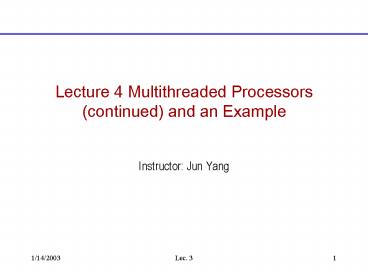Lecture 4 Multithreaded Processors continued and an Example - PowerPoint PPT Presentation
1 / 16
Title:
Lecture 4 Multithreaded Processors continued and an Example
Description:
Child threads are relatively short (tens of instructions), often need to ... Memory controllers and bus interface units. No on-chip caches (except for StrongARM core) ... – PowerPoint PPT presentation
Number of Views:28
Avg rating:3.0/5.0
Title: Lecture 4 Multithreaded Processors continued and an Example
1
Lecture 4 Multithreaded Processors (continued)
and an Example
- Instructor Jun Yang
2
Implicitly Multithreaded Processors
- Explicit Multithreading (covered in last class)
programmer /compiler create multiple threads. - Implicit multithreading dynamically spawn
threads (with the help of compiler), number of
active threads varies. - Child threads are relatively short (tens of
instructions), often need to communicate large
amounts of state with other threads to resolve
data and control dependences. - How are threads created?
- How are register data dependences resolved?
- How are memory data dependences resolved?
3
Thread Creation
- Control independence
- Future threads
A
B
C
4
Thread Creation
- Out-of-order thread creation, DMT
- Creation of C and H is out of program order
- The reorder buffer has to support out-of-order
insertion of an arbitrary number of instructions
into the middle of a set of already active
instructions.
5
Thread Creation
- Disjoint Eager Execution (DEE)
- Eager execution execute both paths following a
branch. - Explosion of paths as multiple branches are
traversed - DEE prune the decision tree according to branch
prediction rate, spawn thread along high rated
branch path.
1
5
2
0.75
0.25
3
0.19
0.56
4
0.42
0.14
0.32
0.24
6
Where Are They Running
- Partition execution resources, each thread runs
on each partition, each partition can be less
aggressive. - Much like on-chip multiprocessor.
- E.g. thread-level speculation (TLS) creates a
thread for each iteration of a loop. Each
iteration is run on a core. - Rely on an SMT-like processor, interleaves
implicit threads (instead of explicit threads). - E.g. DMT spawns threads at procedure calls
backward loop branches. Threads share the
existing reourses. - Multiple processing elements structured as a
circular queue. Each element executes one thread.
The tail of the queue is the current thread
(non-speculative), others are executing future
threads (can be speculative). - E.g. Multiscalar allows creation of a thread at
arbitrary points in programs control flow.
7
Resolving Register Data Dependences
- Intrathread dependences are handled with standard
techniques. - Interthread dependences are hard
- A new future thread might need a register read at
the beginning. But its producer may be at the end
of the prior thread. The producer instruction
might not even be fetched. - Disallow reg. data dependences. Communicate all
shared operands through memory w/ loads and
stores, e.g. TLS. - Compiler tells the dependences explicitly. Embeds
a write mask in future thread, telling which
registers have pending writes to them., e.g.
Multiscalar. - Speculatively execute as if the operands are
ready. Recover if wrong. E.g. DMT.
8
Resolving Memory Data Depend.
- Intrathread memory dependences are resolved w/
standard tech. - WAR and WAW interthread dependences buffer
writes from future threads and committing them
when the threads retire. - RAW interthread memory dependence resolution
(complex!) - A load in later thread searches an aliasing store
in earlier threads store queue (bypass). A store
in an earlier thread searches an aliasing load
(already executed) in a later threads load queue
(a violation). E.g. DMT, DEE. - Centralized address resolution buffer (ARB). One
entry for each load in future thread and any
aliased store from old threads flag a violation
(future thread will be squashed and restarted).
Each load is checked with all unretired stores
also in ARB. E.g. Multscalar
9
Concluding Remarks
- IMT exists only in research proposals up to now.
- Implementation details are difficult.
10
Case Study
- The Intel IXP 12XX Network Processor Family
- IXP 1200 contains
- StrongARM processor core.
- 6 microengines (ME), each of which is a
programmable 32-bit RISC processor. - Memory controllers and bus interface units.
- No on-chip caches (except for StrongARM core).
- ME supports up to 4 threads running in a
coarse-grained fashion.
11
(No Transcript)
12
(No Transcript)
13
(No Transcript)
14
Pipeline Stages
15
Branch Decisions
- Branches are classified into 3 classes
- Class 1 branches are resolved in stage P1
instruction in P0 may be aborted - Class 2 branches are resolved either in P2 or P1
depending the condition set by instruction in P3
instruction in P0,P1 may be aborted. - Class 3 branches are resolved in P3
instructions in P0,1,2 may be aborted.
16
Context Switch
- Specified by instruction explicitly.
- Overhead is at most 1 cycle a context switch
instruction is a class 1 branch instruction which
is resolved in P1. - If delayed branch is present, this 1 cycle loss
can be removed. - Needs to update event signals.
- Context event arbiter wakes up a thread
(round-robin fashion)































